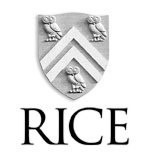welcome to The Whitmire Research Group
Department of Chemistry
Rice University

welcome to The Whitmire Research Group
Department of Chemistry
Rice University
The Whitmire research group has been actively involved in the synthesis of new inorganic and organometallic compounds. We are particularly interested in building molecules that contain both main group elements and transition metals in order to understand the unusual structure and bonding patterns that arise in these mixed systems. These efforts lie in two general areas: (1) the development of metal cluster compounds and (2) the creation of new alkoxide and carboxylate coordination compounds. In both cases, the resulting molecules are being examined as potential single-source precursors to advanced materials.
The metal cluster complexes are generally low-valent compounds supported with carbonyl or phosphine ligands, and they are ideally configured to support catalytic reactions involving hydrogenation and/or carbonylation of organic substrates. They exhibit interesting fundamentally new structure and bonding patterns that result from the unique combination of main group elements and transition metals, and their theoretical investigation is used to gain insight into these novel new patterns. These compounds often show interesting fluxional processes, and these dynamics can be investigated by multinuclear and variable temperature NMR. Some of the molecules in this class may also be used to prepare nanoparticles as they decompose to solid state materials easily and cleanly. Their use as soluble precursor compounds affords potential control over size and properties. In this way, material nanoparticles of main group element-transition metal alloys can be created.

Professor Kenton H. Whitmire
Contact Information:
Department of Chemistry MS 60, Rice University, 6100 Main Street Houston, TX 77005-1892, USA
Phone: 713-348-5650
Fax: 713-348-5155
E-mail: whitmir@rice.edu




The heterometallic alkoxide and carboxylate complexes also have a variety of applications. Heterometallic oxides containing both a main group element and a transition metal have a wide variety of uses including ferroelectrics, piezoelectrics, oxide-ion conducting solids, oxidation catalysis, catalysts for the photochemical decomposition of water into hydrogen and oxygen, high Tc superconductors, etc. We have been in the process of creating molecules that can serve as single source precursors to a variety of target compositions. Additionally, these compounds show interesting structure and reactivity patterns. Some compounds we have prepared such as derivatives of bismuth salicylate also have potential biological activity and can be used as model compounds for how such drugs work in the body.
These molecules are used to create new alloy, oxide, phosphide, and chalcogenide nanoparticles. In general we use known or new (i.e. synthesized in our laboratory) homo– and heterometallic compounds that possess the targeted metal stoichiometry. We have been successful in obtaining nanoparticles with compositions that have previously only been obtained in bulk samples prepared by conventional methods. An interesting advantage of the nanoparticle production is that, under appropriate conditions, new nanoparticles shapes (nanocrosses, stars, truncated cubes, etc,) can be prepared.
Coworkers in the group learn a wide variety of experimental techniques for assaulting the problems associated with synthesizing, characterizing and probing the properties and reactivities of both molecular and solid state compounds. These include nuclear magnetic resonance (NMR, multinuclear and variable temperature in addition to conventional 1H, 13C, 31P and 19F studies), mass spectroscopy (MS), infrared (IR) and Raman spectroscopy, UV-vis spectroscopy, single crystal and powder X-ray diffraction methods, scanning and transmission electron microscopy (SEM and TEM), x-ray photoelectron spectroscopy (XPS) and atomic force microscopy (AFM), among others.